Public Access Computing Project: Requirements for Madtown City Library
VerifiedAdded on 2020/04/21
|8
|1663
|110
Report
AI Summary
This report details the requirements for a Public Access Computing (PAC) project proposed by the Madtown City Council. The project aims to establish a PAC room within the city library, providing free or affordable computer and internet access to the public. The report addresses key questions, including project objectives (providing computer and internet access, offering educational resources, and offering technical support), hardware and software specifications (six computers, printers, scanners, headphones, and a range of software including operating systems, educational tools, and antivirus), internet access restrictions (blocking access to inappropriate websites), budget constraints (a budget of 3,500 pounds), and security measures (ensuring data privacy and administrator control). The report also outlines the hardware and software requirements, including PCs, printers, scanners, headphones, routers, the latest OS, educational software, browsers and antivirus software, and also references the sources used.
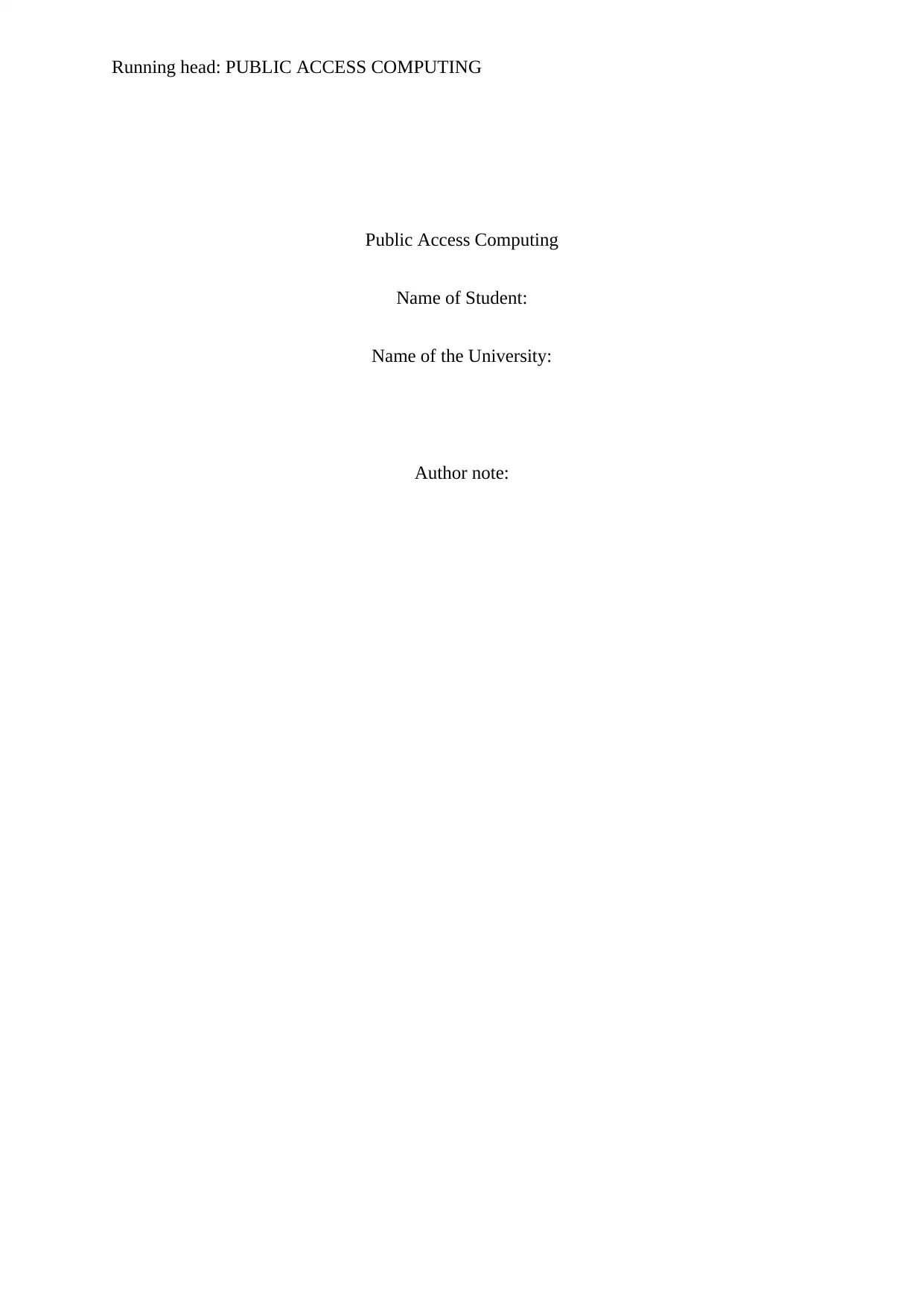
Running head: PUBLIC ACCESS COMPUTING
Public Access Computing
Name of Student:
Name of the University:
Author note:
Public Access Computing
Name of Student:
Name of the University:
Author note:
Paraphrase This Document
Need a fresh take? Get an instant paraphrase of this document with our AI Paraphraser
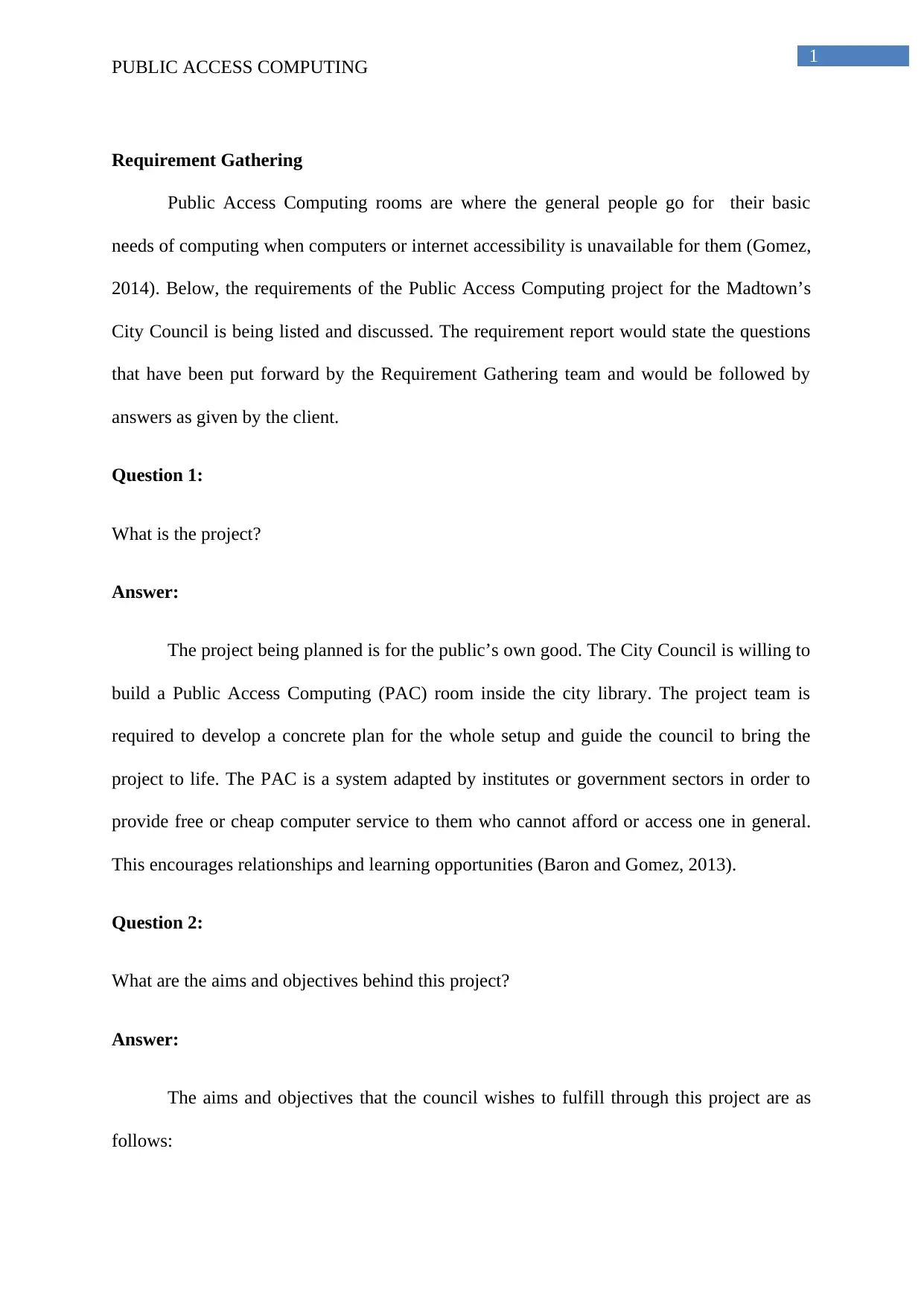
1
PUBLIC ACCESS COMPUTING
Requirement Gathering
Public Access Computing rooms are where the general people go for their basic
needs of computing when computers or internet accessibility is unavailable for them (Gomez,
2014). Below, the requirements of the Public Access Computing project for the Madtown’s
City Council is being listed and discussed. The requirement report would state the questions
that have been put forward by the Requirement Gathering team and would be followed by
answers as given by the client.
Question 1:
What is the project?
Answer:
The project being planned is for the public’s own good. The City Council is willing to
build a Public Access Computing (PAC) room inside the city library. The project team is
required to develop a concrete plan for the whole setup and guide the council to bring the
project to life. The PAC is a system adapted by institutes or government sectors in order to
provide free or cheap computer service to them who cannot afford or access one in general.
This encourages relationships and learning opportunities (Baron and Gomez, 2013).
Question 2:
What are the aims and objectives behind this project?
Answer:
The aims and objectives that the council wishes to fulfill through this project are as
follows:
PUBLIC ACCESS COMPUTING
Requirement Gathering
Public Access Computing rooms are where the general people go for their basic
needs of computing when computers or internet accessibility is unavailable for them (Gomez,
2014). Below, the requirements of the Public Access Computing project for the Madtown’s
City Council is being listed and discussed. The requirement report would state the questions
that have been put forward by the Requirement Gathering team and would be followed by
answers as given by the client.
Question 1:
What is the project?
Answer:
The project being planned is for the public’s own good. The City Council is willing to
build a Public Access Computing (PAC) room inside the city library. The project team is
required to develop a concrete plan for the whole setup and guide the council to bring the
project to life. The PAC is a system adapted by institutes or government sectors in order to
provide free or cheap computer service to them who cannot afford or access one in general.
This encourages relationships and learning opportunities (Baron and Gomez, 2013).
Question 2:
What are the aims and objectives behind this project?
Answer:
The aims and objectives that the council wishes to fulfill through this project are as
follows:
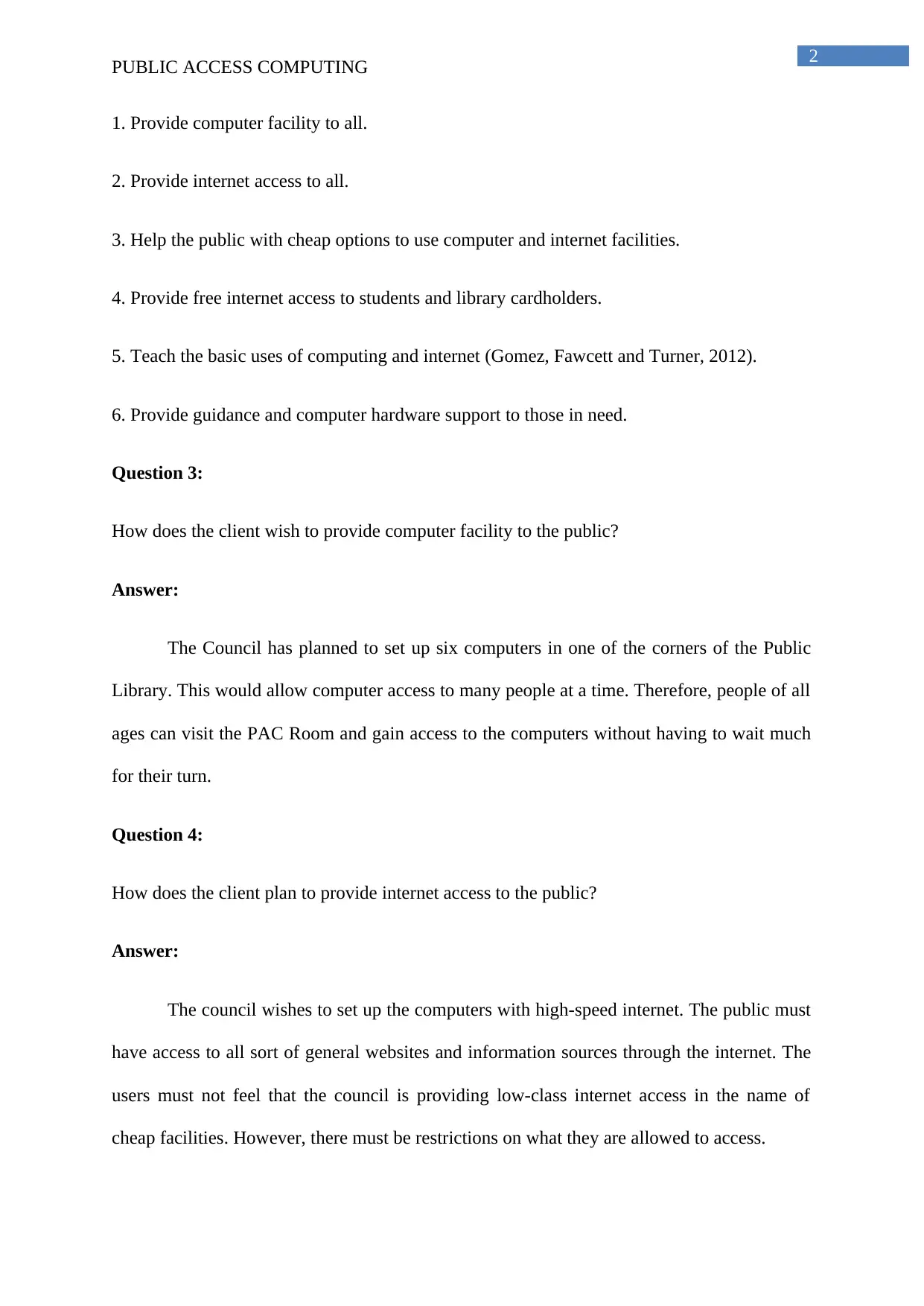
2
PUBLIC ACCESS COMPUTING
1. Provide computer facility to all.
2. Provide internet access to all.
3. Help the public with cheap options to use computer and internet facilities.
4. Provide free internet access to students and library cardholders.
5. Teach the basic uses of computing and internet (Gomez, Fawcett and Turner, 2012).
6. Provide guidance and computer hardware support to those in need.
Question 3:
How does the client wish to provide computer facility to the public?
Answer:
The Council has planned to set up six computers in one of the corners of the Public
Library. This would allow computer access to many people at a time. Therefore, people of all
ages can visit the PAC Room and gain access to the computers without having to wait much
for their turn.
Question 4:
How does the client plan to provide internet access to the public?
Answer:
The council wishes to set up the computers with high-speed internet. The public must
have access to all sort of general websites and information sources through the internet. The
users must not feel that the council is providing low-class internet access in the name of
cheap facilities. However, there must be restrictions on what they are allowed to access.
PUBLIC ACCESS COMPUTING
1. Provide computer facility to all.
2. Provide internet access to all.
3. Help the public with cheap options to use computer and internet facilities.
4. Provide free internet access to students and library cardholders.
5. Teach the basic uses of computing and internet (Gomez, Fawcett and Turner, 2012).
6. Provide guidance and computer hardware support to those in need.
Question 3:
How does the client wish to provide computer facility to the public?
Answer:
The Council has planned to set up six computers in one of the corners of the Public
Library. This would allow computer access to many people at a time. Therefore, people of all
ages can visit the PAC Room and gain access to the computers without having to wait much
for their turn.
Question 4:
How does the client plan to provide internet access to the public?
Answer:
The council wishes to set up the computers with high-speed internet. The public must
have access to all sort of general websites and information sources through the internet. The
users must not feel that the council is providing low-class internet access in the name of
cheap facilities. However, there must be restrictions on what they are allowed to access.
⊘ This is a preview!⊘
Do you want full access?
Subscribe today to unlock all pages.

Trusted by 1+ million students worldwide

3
PUBLIC ACCESS COMPUTING
Question 5:
What restrictions are exactly being talked about?
Answer:
The aim of this project is to allow users to access basic and necessary stuffs on the
internet. It is only for their educational, business or emergency purposes. People should
however not be allowed to access restricted websites. Adult websites, websites that promote
hatred or unethical contents, betting websites and their likes shall all be excluded from the list
of those that are allowed.
Question 6:
Should there be manual checking of the restricted websites or a technical assistance is
needed?
Answer:
Manually keeping eye on every user and their internet usage is a tough task.
Furthermore, it would also be against the security ethics that we provide. Therefore, it would
be best to provide technical assistance in this field. The websites that are ethically harmful to
the community or are unsuitable to the public service environment should be kept behind bars
by technical means. In addition, shall the council administrator prefer to keep reports of
people who were trying to access such websites intentionally. The council research team will
work on it and hand over the final report with the list of all such websites and the details of
the same.
Question 7:
What is the budget of the project?
PUBLIC ACCESS COMPUTING
Question 5:
What restrictions are exactly being talked about?
Answer:
The aim of this project is to allow users to access basic and necessary stuffs on the
internet. It is only for their educational, business or emergency purposes. People should
however not be allowed to access restricted websites. Adult websites, websites that promote
hatred or unethical contents, betting websites and their likes shall all be excluded from the list
of those that are allowed.
Question 6:
Should there be manual checking of the restricted websites or a technical assistance is
needed?
Answer:
Manually keeping eye on every user and their internet usage is a tough task.
Furthermore, it would also be against the security ethics that we provide. Therefore, it would
be best to provide technical assistance in this field. The websites that are ethically harmful to
the community or are unsuitable to the public service environment should be kept behind bars
by technical means. In addition, shall the council administrator prefer to keep reports of
people who were trying to access such websites intentionally. The council research team will
work on it and hand over the final report with the list of all such websites and the details of
the same.
Question 7:
What is the budget of the project?
Paraphrase This Document
Need a fresh take? Get an instant paraphrase of this document with our AI Paraphraser

4
PUBLIC ACCESS COMPUTING
Answer:
The council has a very strict budget assigned to this project. For the complete process,
the council is willing to spend up to 3,500 Pounds. This includes the cost of all six computers,
their setting ups, software requirements, external hardware requirements and the network
requirements.
Question 8:
Being on a very strict budget, what specifications is the client willing to achieve in their
systems?
Answer:
The computers should be of the latest generation. The machines should be able to
maximize the efforts made by the students for their projects or assignment purposes.
Furthermore, the systems must be able to run all academic and simple business purpose
software without fail or complications. With an aim to preserve energy, one of the main
aspects of this project is to use energy efficient hardware parts for the computers to operate.
Question 9:
Apart from the Personal Computers, what extra hardware components does the client wish to
purchase and set up?
Answer:
Scanners and printers must also be provided with each computer. Headphones with
microphones must also be supplied for each computer.
Question 10:
PUBLIC ACCESS COMPUTING
Answer:
The council has a very strict budget assigned to this project. For the complete process,
the council is willing to spend up to 3,500 Pounds. This includes the cost of all six computers,
their setting ups, software requirements, external hardware requirements and the network
requirements.
Question 8:
Being on a very strict budget, what specifications is the client willing to achieve in their
systems?
Answer:
The computers should be of the latest generation. The machines should be able to
maximize the efforts made by the students for their projects or assignment purposes.
Furthermore, the systems must be able to run all academic and simple business purpose
software without fail or complications. With an aim to preserve energy, one of the main
aspects of this project is to use energy efficient hardware parts for the computers to operate.
Question 9:
Apart from the Personal Computers, what extra hardware components does the client wish to
purchase and set up?
Answer:
Scanners and printers must also be provided with each computer. Headphones with
microphones must also be supplied for each computer.
Question 10:
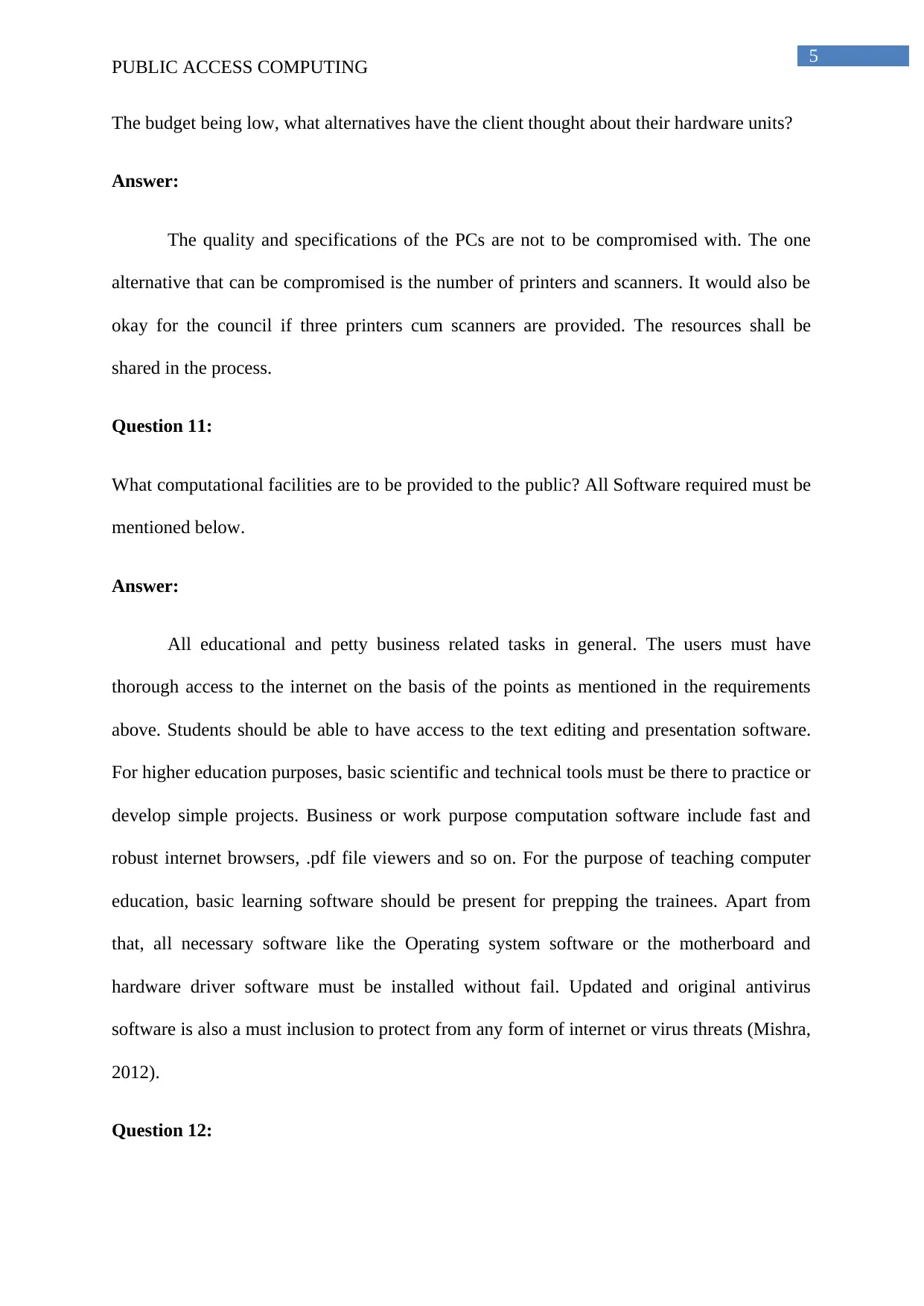
5
PUBLIC ACCESS COMPUTING
The budget being low, what alternatives have the client thought about their hardware units?
Answer:
The quality and specifications of the PCs are not to be compromised with. The one
alternative that can be compromised is the number of printers and scanners. It would also be
okay for the council if three printers cum scanners are provided. The resources shall be
shared in the process.
Question 11:
What computational facilities are to be provided to the public? All Software required must be
mentioned below.
Answer:
All educational and petty business related tasks in general. The users must have
thorough access to the internet on the basis of the points as mentioned in the requirements
above. Students should be able to have access to the text editing and presentation software.
For higher education purposes, basic scientific and technical tools must be there to practice or
develop simple projects. Business or work purpose computation software include fast and
robust internet browsers, .pdf file viewers and so on. For the purpose of teaching computer
education, basic learning software should be present for prepping the trainees. Apart from
that, all necessary software like the Operating system software or the motherboard and
hardware driver software must be installed without fail. Updated and original antivirus
software is also a must inclusion to protect from any form of internet or virus threats (Mishra,
2012).
Question 12:
PUBLIC ACCESS COMPUTING
The budget being low, what alternatives have the client thought about their hardware units?
Answer:
The quality and specifications of the PCs are not to be compromised with. The one
alternative that can be compromised is the number of printers and scanners. It would also be
okay for the council if three printers cum scanners are provided. The resources shall be
shared in the process.
Question 11:
What computational facilities are to be provided to the public? All Software required must be
mentioned below.
Answer:
All educational and petty business related tasks in general. The users must have
thorough access to the internet on the basis of the points as mentioned in the requirements
above. Students should be able to have access to the text editing and presentation software.
For higher education purposes, basic scientific and technical tools must be there to practice or
develop simple projects. Business or work purpose computation software include fast and
robust internet browsers, .pdf file viewers and so on. For the purpose of teaching computer
education, basic learning software should be present for prepping the trainees. Apart from
that, all necessary software like the Operating system software or the motherboard and
hardware driver software must be installed without fail. Updated and original antivirus
software is also a must inclusion to protect from any form of internet or virus threats (Mishra,
2012).
Question 12:
⊘ This is a preview!⊘
Do you want full access?
Subscribe today to unlock all pages.

Trusted by 1+ million students worldwide
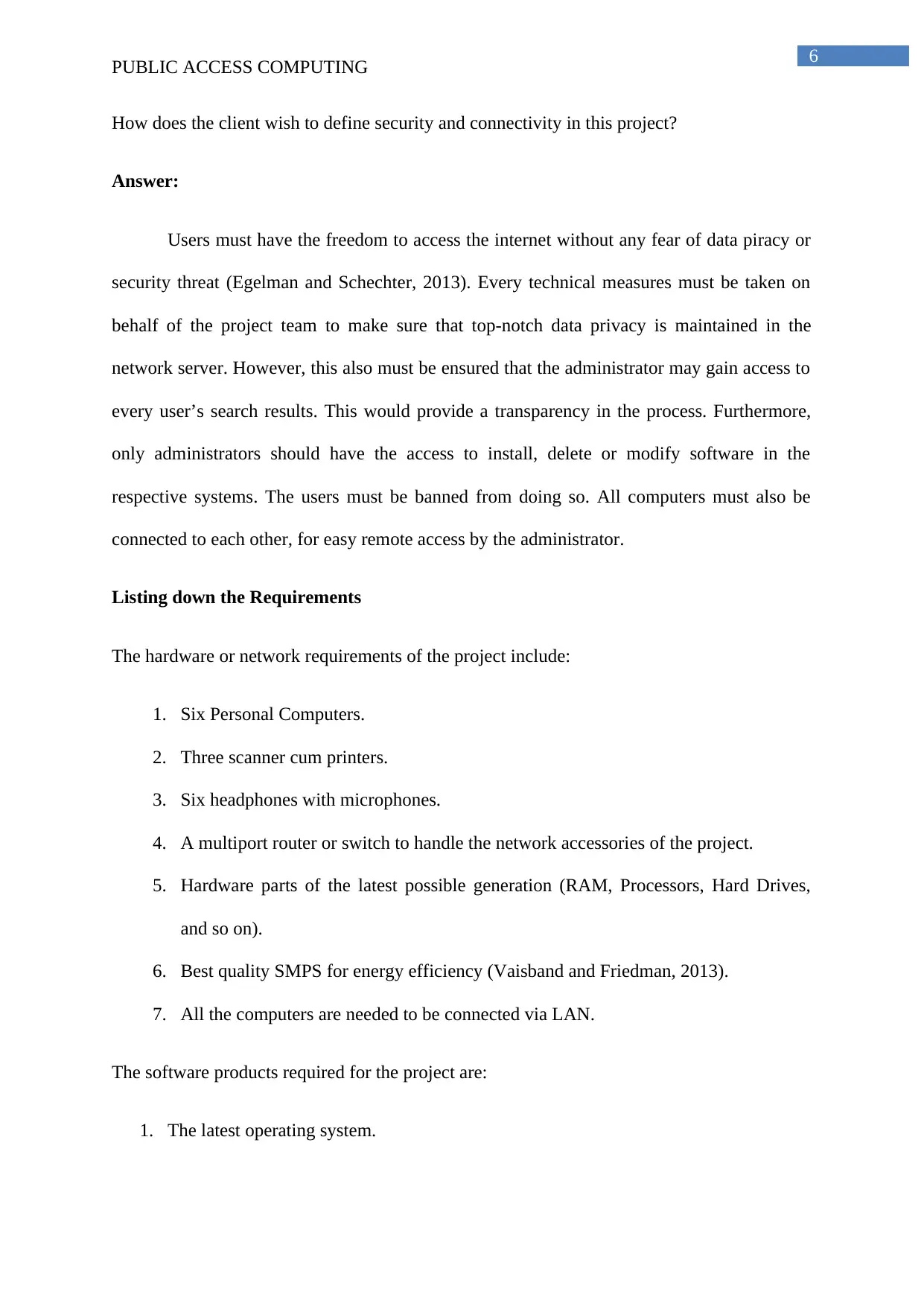
6
PUBLIC ACCESS COMPUTING
How does the client wish to define security and connectivity in this project?
Answer:
Users must have the freedom to access the internet without any fear of data piracy or
security threat (Egelman and Schechter, 2013). Every technical measures must be taken on
behalf of the project team to make sure that top-notch data privacy is maintained in the
network server. However, this also must be ensured that the administrator may gain access to
every user’s search results. This would provide a transparency in the process. Furthermore,
only administrators should have the access to install, delete or modify software in the
respective systems. The users must be banned from doing so. All computers must also be
connected to each other, for easy remote access by the administrator.
Listing down the Requirements
The hardware or network requirements of the project include:
1. Six Personal Computers.
2. Three scanner cum printers.
3. Six headphones with microphones.
4. A multiport router or switch to handle the network accessories of the project.
5. Hardware parts of the latest possible generation (RAM, Processors, Hard Drives,
and so on).
6. Best quality SMPS for energy efficiency (Vaisband and Friedman, 2013).
7. All the computers are needed to be connected via LAN.
The software products required for the project are:
1. The latest operating system.
PUBLIC ACCESS COMPUTING
How does the client wish to define security and connectivity in this project?
Answer:
Users must have the freedom to access the internet without any fear of data piracy or
security threat (Egelman and Schechter, 2013). Every technical measures must be taken on
behalf of the project team to make sure that top-notch data privacy is maintained in the
network server. However, this also must be ensured that the administrator may gain access to
every user’s search results. This would provide a transparency in the process. Furthermore,
only administrators should have the access to install, delete or modify software in the
respective systems. The users must be banned from doing so. All computers must also be
connected to each other, for easy remote access by the administrator.
Listing down the Requirements
The hardware or network requirements of the project include:
1. Six Personal Computers.
2. Three scanner cum printers.
3. Six headphones with microphones.
4. A multiport router or switch to handle the network accessories of the project.
5. Hardware parts of the latest possible generation (RAM, Processors, Hard Drives,
and so on).
6. Best quality SMPS for energy efficiency (Vaisband and Friedman, 2013).
7. All the computers are needed to be connected via LAN.
The software products required for the project are:
1. The latest operating system.
Paraphrase This Document
Need a fresh take? Get an instant paraphrase of this document with our AI Paraphraser
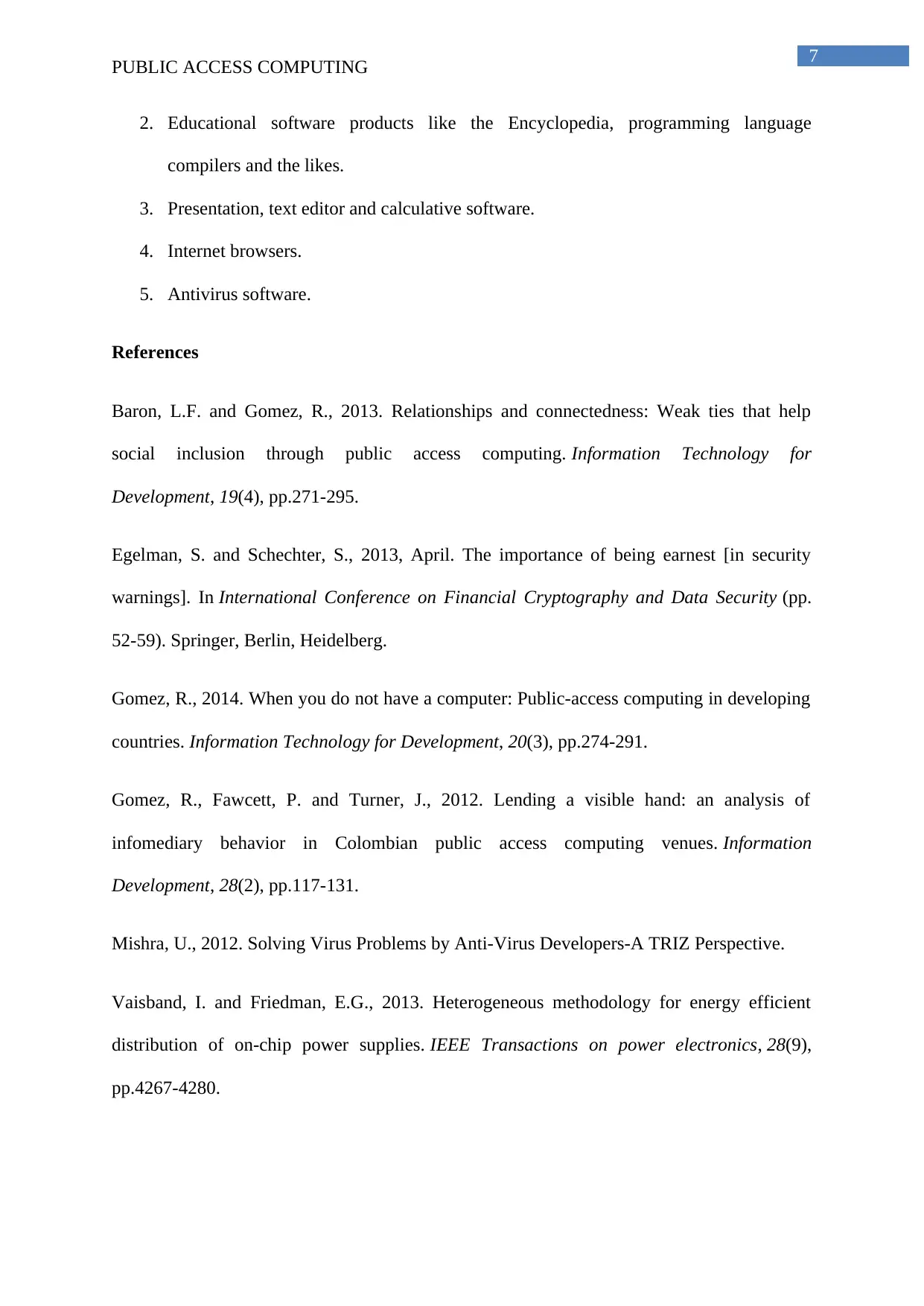
7
PUBLIC ACCESS COMPUTING
2. Educational software products like the Encyclopedia, programming language
compilers and the likes.
3. Presentation, text editor and calculative software.
4. Internet browsers.
5. Antivirus software.
References
Baron, L.F. and Gomez, R., 2013. Relationships and connectedness: Weak ties that help
social inclusion through public access computing. Information Technology for
Development, 19(4), pp.271-295.
Egelman, S. and Schechter, S., 2013, April. The importance of being earnest [in security
warnings]. In International Conference on Financial Cryptography and Data Security (pp.
52-59). Springer, Berlin, Heidelberg.
Gomez, R., 2014. When you do not have a computer: Public-access computing in developing
countries. Information Technology for Development, 20(3), pp.274-291.
Gomez, R., Fawcett, P. and Turner, J., 2012. Lending a visible hand: an analysis of
infomediary behavior in Colombian public access computing venues. Information
Development, 28(2), pp.117-131.
Mishra, U., 2012. Solving Virus Problems by Anti-Virus Developers-A TRIZ Perspective.
Vaisband, I. and Friedman, E.G., 2013. Heterogeneous methodology for energy efficient
distribution of on-chip power supplies. IEEE Transactions on power electronics, 28(9),
pp.4267-4280.
PUBLIC ACCESS COMPUTING
2. Educational software products like the Encyclopedia, programming language
compilers and the likes.
3. Presentation, text editor and calculative software.
4. Internet browsers.
5. Antivirus software.
References
Baron, L.F. and Gomez, R., 2013. Relationships and connectedness: Weak ties that help
social inclusion through public access computing. Information Technology for
Development, 19(4), pp.271-295.
Egelman, S. and Schechter, S., 2013, April. The importance of being earnest [in security
warnings]. In International Conference on Financial Cryptography and Data Security (pp.
52-59). Springer, Berlin, Heidelberg.
Gomez, R., 2014. When you do not have a computer: Public-access computing in developing
countries. Information Technology for Development, 20(3), pp.274-291.
Gomez, R., Fawcett, P. and Turner, J., 2012. Lending a visible hand: an analysis of
infomediary behavior in Colombian public access computing venues. Information
Development, 28(2), pp.117-131.
Mishra, U., 2012. Solving Virus Problems by Anti-Virus Developers-A TRIZ Perspective.
Vaisband, I. and Friedman, E.G., 2013. Heterogeneous methodology for energy efficient
distribution of on-chip power supplies. IEEE Transactions on power electronics, 28(9),
pp.4267-4280.
1 out of 8
Related Documents
Your All-in-One AI-Powered Toolkit for Academic Success.
+13062052269
info@desklib.com
Available 24*7 on WhatsApp / Email
![[object Object]](/_next/static/media/star-bottom.7253800d.svg)
Unlock your academic potential
Copyright © 2020–2025 A2Z Services. All Rights Reserved. Developed and managed by ZUCOL.




